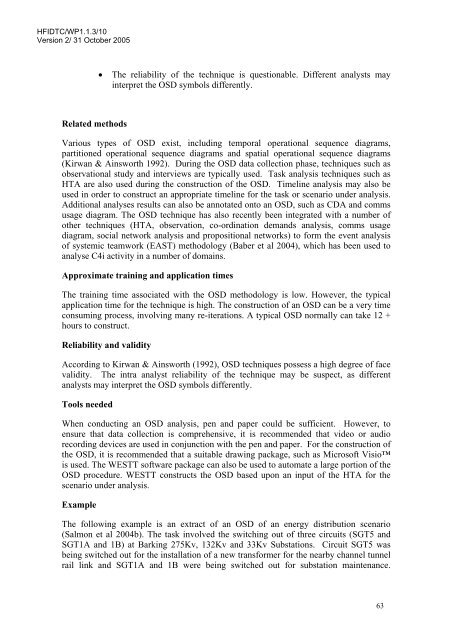A Review of the Event Analysis of Systemic Teamwork Methodology
A Review of the Event Analysis of Systemic Teamwork Methodology
A Review of the Event Analysis of Systemic Teamwork Methodology
- No tags were found...
Create successful ePaper yourself
Turn your PDF publications into a flip-book with our unique Google optimized e-Paper software.
HFIDTC/WP1.1.3/10<br />
Version 2/ 31 October 2005<br />
• The reliability <strong>of</strong> <strong>the</strong> technique is questionable. Different analysts may<br />
interpret <strong>the</strong> OSD symbols differently.<br />
Related methods<br />
Various types <strong>of</strong> OSD exist, including temporal operational sequence diagrams,<br />
partitioned operational sequence diagrams and spatial operational sequence diagrams<br />
(Kirwan & Ainsworth 1992). During <strong>the</strong> OSD data collection phase, techniques such as<br />
observational study and interviews are typically used. Task analysis techniques such as<br />
HTA are also used during <strong>the</strong> construction <strong>of</strong> <strong>the</strong> OSD. Timeline analysis may also be<br />
used in order to construct an appropriate timeline for <strong>the</strong> task or scenario under analysis.<br />
Additional analyses results can also be annotated onto an OSD, such as CDA and comms<br />
usage diagram. The OSD technique has also recently been integrated with a number <strong>of</strong><br />
o<strong>the</strong>r techniques (HTA, observation, co-ordination demands analysis, comms usage<br />
diagram, social network analysis and propositional networks) to form <strong>the</strong> event analysis<br />
<strong>of</strong> systemic teamwork (EAST) methodology (Baber et al 2004), which has been used to<br />
analyse C4i activity in a number <strong>of</strong> domains.<br />
Approximate training and application times<br />
The training time associated with <strong>the</strong> OSD methodology is low. However, <strong>the</strong> typical<br />
application time for <strong>the</strong> technique is high. The construction <strong>of</strong> an OSD can be a very time<br />
consuming process, involving many re-iterations. A typical OSD normally can take 12 +<br />
hours to construct.<br />
Reliability and validity<br />
According to Kirwan & Ainsworth (1992), OSD techniques possess a high degree <strong>of</strong> face<br />
validity. The intra analyst reliability <strong>of</strong> <strong>the</strong> technique may be suspect, as different<br />
analysts may interpret <strong>the</strong> OSD symbols differently.<br />
Tools needed<br />
When conducting an OSD analysis, pen and paper could be sufficient. However, to<br />
ensure that data collection is comprehensive, it is recommended that video or audio<br />
recording devices are used in conjunction with <strong>the</strong> pen and paper. For <strong>the</strong> construction <strong>of</strong><br />
<strong>the</strong> OSD, it is recommended that a suitable drawing package, such as Micros<strong>of</strong>t Visio<br />
is used. The WESTT s<strong>of</strong>tware package can also be used to automate a large portion <strong>of</strong> <strong>the</strong><br />
OSD procedure. WESTT constructs <strong>the</strong> OSD based upon an input <strong>of</strong> <strong>the</strong> HTA for <strong>the</strong><br />
scenario under analysis.<br />
Example<br />
The following example is an extract <strong>of</strong> an OSD <strong>of</strong> an energy distribution scenario<br />
(Salmon et al 2004b). The task involved <strong>the</strong> switching out <strong>of</strong> three circuits (SGT5 and<br />
SGT1A and 1B) at Barking 275Kv, 132Kv and 33Kv Substations. Circuit SGT5 was<br />
being switched out for <strong>the</strong> installation <strong>of</strong> a new transformer for <strong>the</strong> nearby channel tunnel<br />
rail link and SGT1A and 1B were being switched out for substation maintenance.<br />
63
















